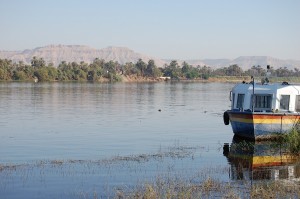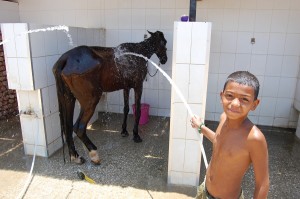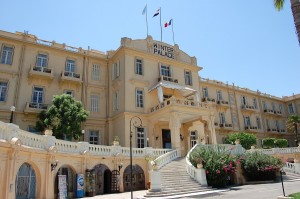
Sarah Loat
By Sarah Loat
As the searing heat of the Egyptian sun releases its grip on Luxor a little, now is the perfect season to venture back to the beginning of time.
Post-revolutionary Luxor has been hit hard. This ancient capital of Egypt has been left bereft of tourists and the economy is struggling. Little else has changed; the temples still stand as they have for millennia and the Nile still enchants.
All the reasons why Luxor has attracted tourists for centuries and why it should definitely be on your bucket list – never has there been a better time to get a reduced-rate hotel room, from back packer’s lodges up to 5 star luxury. And Luxor needs you now!
The city is a treasure trove of ancient Egyptian wonder and has some of the world’s most awe-inspiring sights. Luxor has, somewhat unfairly, built a reputation for being the hassle capital of Egypt. It is true, it can be intimidating to have feluccas and caleche rides and West Bank tours thrust at you, seemingly by every person you pass in the street. But greet them with humour and politeness and remember, they are only trying to make a living.
Adrift on the Nile
A felucca trip is obligatory, and at approximately EGP 50 an hour you would be foolish to pass up such a tranquil experience, where the Nile is at its most beautiful. Felucca crews are adeptly skilled at reading the conditions and capturing every ounce of available wind in their sails. Lazily dragging one hand in the water you will see children playing football on islands that appear when water levels are low.
Dust gets kicked up as they race barefoot after the ball and splash about in the Nile to cool off, watched nonchalantly by grazing buffalo, donkeys and camels.
The felucca captain may even entertain you with some Saidi or Nubian songs, done with the genuine warmth and humour that only Saidis can bring. You will be offered a glass of hot tea, half a glass of sugar, half a glass of tea! or a cool soft drink. Hospitality is second nature to Luxor people.
Nile cruises have always been a popular way to explore Egypt’s historical sites, usually with a cruise from Luxor to Aswan. After a 15 year hiatus, the Egyptian government has given permission for an extended Nile cruise to operate between Cairo and Luxor or Aswan, in an attempt to reinvigorate tourism. You will need at least two weeks for this journey and fairly deep pockets – but what a spectacular way to see Egypt!
The beauty of a Nile cruise is that you are literally hand delivered to the most important sites and everything is taken care of for you. Perfect if you are a temple first-timer, otherwise you may prefer to explore at your own pace, in which case a stay in Luxor itself is a must.
For a more glamorous splash of a bygone era, try the recently revived dahabiya cruises. These beautifully crafted, elegant sailboats offer a Nile cruise experience on a more romantic and intimate scale. Dahabiyas offer a taste of luxury with all the mod-cons you would expect of a top class hotel, with a daily changing, unique Nile view.
The more adventurous or budget conscious could consider chartering their own felucca or pitch in with other like-minded travellers to spend two to three nights on a traditional wooden felucca sailboat, experiencing the outdoors with the stars as their blanket. You will sleep on cushions on the deck of the felucca and really get back to basics. No air-conditioning, no showers, no rest-rooms – no frills – all adventure!
Pharaohs and Kings, Temples and Tombs

Sarah Loat
It is easy to see why the pharaohs chose Luxor as their capital and the city of the God Amon-Ra. The East Bank, with the rising sun, was dedicated to the living and the West Bank was where they laid their kings to rest together with the setting sun. Known as an “open-air museum,” the concentration of tombs and temples is mind-blowing, with new tombs being discovered all the time
Travellers can get temple-weary as one temple begins to look like another, but if you only visit one temple you hands-down must visit the awe-inspiring Karnak temple, dedicated to the God Amon-Ra.
May the evening soothe and welcome you,
O traveller from Upper Egypt.
You will travel no further because you are come.
Here you are at the beginning of time.
With these dramatic opening words of the spectacular after-dark Karnak sound and light show, you are suddenly transported back centuries in time, to the era of Gods and Pharaohs, at the largest ancient religious site in the world. The sheer scale and craftsmanship will literally give you chills, regardless of the outside temperature. It is an enormous complex and a guide is really valuable, especially if it is your first visit. While it will be no less awe-inspiring without a guide, you will miss so much fascinating detail.
The temples have been adjusted and adorned by up to 30 successive pharaohs of Egypt, and still has one standing pink granite obelisk of the only female pharaoh, Hatshepsut. It is huge, and the tallest obelisk standing in Egypt. The inscription begins: “I was sitting in the palace and I remembered the One who created me; my heart directed me to make for him two obelisks of electrum.
“ At the Sacred Lake you will find another fallen obelisk, which allows you to get a really close look at the inscriptions. Also near the Sacred Lake is a statue of a giant scarab beetle and legend has it that it is bestowed with an ancient charm that grants fertility to those that circle it seven times.
Luxor temple is a beautiful temple that stands parallel to the Nile. You will see it from a felucca ride on the river, or it is a short walk from most hotels in Luxor. There has been some updating to the exterior grounds in recent years, with an ongoing restoration of the “Avenue of Sphinxes” which links both Luxor and Karnak temples. The entrance is stunning and one obelisk now stands where there were originally two. Knowing that the other one is in Paris, you cannot help but wish they would give it back.
This temple has been used for worship for thousands of years, and still is today! Part of the Hypostyle Hall was converted into a Christian church and centuries later a mosque was built over the buried temple and still remains today – Abu Haggag mosque – after the temple was uncovered, as an integral part of the temple.
One of the most underrated temples is that of Medinet Habu. It is largely overlooked by tour groups, which means you may get the temple all to yourself if you pay it a visit. It is one of Luxor’s best preserved temples and tells incredible stories of battles with the “Sea Peoples.”
Dendera and Abydos temples are some of the most complete and spectacular temples in Egypt – Luxor is a great base to reach them from. For a full day out visit Dendera on a day cruise on the Lotus boat.
The Valley of the Kings, Queens and Nobles, aside from Karnak temple, are what most tourists come to Luxor for. Here is the resting ground of the pharaohs and of the fabled boy king, Tutankhamun. Tutankhamun’s tomb can be a disappointment; his is of smaller size and more hastily finished compared to other tombs of superior beauty and decoration.
Choose the tombs you want to visit wisely, as some require quite some physical effort to reach – climbing up and down stairs and ladders in some instances. Not all tombs will be open as they “rest” on a rotational basis.
All of these excursions can be arranged locally for you by experienced agents in Luxor. They offer great deals and take some of the hassle out of your holiday time. Try Mohamed at La Rose Tours for great customer service. Other reputable agencies can be found near the Winter Palace hotel.

Alternative Luxor
One of the most unique ways to experience the Theban Necropolis is by air. Ballooning over the West Bank is an absolutely magical, breathtaking experience that gives unparalleled views of the Valley of the Kings, and the West Bank temples including, Deir El Bahri (Hatshepsut’s Temple), Medinat Habu, and Howard Carter’s House.
As the early light of dawn begins to bleed over the Nile, softly and gradually the balloons begin to rise. Do not forget to take your camera to capture some amazing shots of the sun as it casts beautiful shadows and colours over the Theban hills.
The balloons rise and dip, riding thermals and gaining better vantage points of the temples, as they drift slowly southwards past some of the most mind-blowing sights in Egypt. Unsurpassed aerial views of some of the world’s greatest monuments, coupled with views of the lush green farmland that butts up against the stark pink of the morning desert.
Expect to pay between EGP 250 to 500 per person for up to an hour in the air. Price is dependent on season and which operator you choose. Try Hod Hod Soliman, who has an excellent service and safety record, or Viking Air.
If hot air ballooning does not satisfy the adrenaline rush you are looking for, then try desert quad biking. It is fast, furious and very dusty. If you prefer the four-legged kind of desert adventure then Nobi Arabian Horse Stables has horses, camels or donkeys for your desert fun.
Come back down to Earth and bring the heavens with you for an evening of stargazing in the desert, where the galaxy literally comes down to the horizon to greet you. Enjoy a Bedouin desert dinner and see space up close through a high-powered telescope.
Animal lovers may have a hard time seeing so many skinny horses pulling carriages or caleches. If you do want to use them for a tour around town, choose a healthy looking horse and take it on a trip to ACE (Animal Care in Egypt).
This exceptional free animal care service will bathe and rub down your caleche owner’s horse, while you have a tour of the premises and meet the animals they care for. Do not barter your caleche driver down to the lowest possible price, no matter how the spirit of bargaining has you in its grip; the animal will only be spending a longer day working to make up the shortfall.
Eat Luxor!
While Luxor is no culinary hot-bed, there are a few places you should not miss. All of the five star hotels have a variety of international dining options, including French, Italian, Thai, Chinese, Indian…and so it goes on. An elegant afternoon high tea at Luxor’s most famous hotel, the Winter Palace is a must. Between 3.30 to 6 pm daily, either on the front terrace or inside in the Victoria Lounge, you can indulge in tea, coffee, cakes, sandwiches and petite fours, while following in the footsteps of Howard Carter, Agatha Christie and King Farouk.
For a special occasion; a birthday, anniversary, or just an indulgent romantic night of fine dining, the 1886 restaurant in the Winter Palace offer sumptuous colonial surroundings and quality French cuisine. Prices are considerably higher than elsewhere in Luxor, but not unreasonable and worth the splurge.
For a sumptuous seafood feast, the locals know Al Hoot is the best place to dine. (You will find it facing Luxor International Hospital). It is a modest restaurant with seafood to die for. Try the seafood soup and find a whole crab inside. African Queen is also worth a visit along with several more rustic places to eat on the West Bank.
El Gezira Hotel is just a short ferry ride across the river and has a relaxing roof terrace where you can enjoy Egyptian food with the backdrop of the Theban hills behind you.
St Joseph’s Hotel on the East Bank is the perfect spot for a sundowner or a casual dinner on its informal roof terrace, which gives breathtaking views of the Nile and Theban necropolis as it lights up at dusk.
For Egypt’s infamous kushari dish, Sayyida Zeinab in Television Street is hard to beat. This tiny kushari joint offers ladlefuls of the tastiest, steaming hot kusharito give you the entire carbohydrate boost you need to tackle temple-hopping. Al Zaem is another good option, just past Luxor temple.

Sarah Loat
Sofra, near the train station, offers an experience something akin to eating at your Egyptian grandmother’s house. Set in a beautifully converted Arabian-style house, Sofra is a visual feast. Dine on the covered roof terrace, or downstairs in one of the individual dining rooms – large wooden dining table, portraits and Arabic calligraphy on the walls, candelabras, and authentic tiles. What you get here is standard Egyptian cuisine, think mezze, tagines, molokheya, pigeon, in a uniquely Egyptian setting.
Snobs is run by a talented young chef who used to cook at the royal palace in Saudi Arabia. Dishes are international and Egyptian, all tasty and all served and presented with a flourish. Find it in El Rhoda el Sherifa Street, alongside several other ex-pat owned restaurants.
Pizza Roma-IT is a true authentic Italian kitchen owned by an Egyptian man and his Italian wife. It simply has the best pizza in Egypt, never mind Luxor. Herbs are grown on the roof and ingredients are sourced fresh on the day. The pizza and pasta menu is extensive and salads are always crisp and fresh. Head to St Joseph’s street to feast Italian-style.
Those with a sweet tooth will be in cake heaven at Twinky, located near Luxor central train station. Indulge in oriental pastries, cakes and all kinds of desserts. Once you have had your fill, top it all off with tea and shisha at Om Kalthoum coffee shop.
Luxor life
Modern day Luxor is a treasure in itself. Out in the West Bank villages, people live in the same rustic way they have for centuries. Men work the fields in white galabeyas, faces etched with hard work and exposure to the Egyptian sun. Buffalo lazily doze on dirt tracks, the breeze rustles the sugar cane fields, and life is altogether operated at a more relaxed pace. The West Bank is composed of a number of villages and farming communities that keep it lush and green.
Cross the train tracks on the East Bank and you venture into local’s territory, where the people of the villages will gladly welcome you. Families picnic on grassy verges, women chat in doorways and men chew the fat over a shisha and some dominoes.
Kids scrabble around trying to be the first to get close to the tourists. They love to practice English and will dazzle you with their ability to get by in a multitude of languages. Bring some pens and a bag of sweets to see happy little faces all round.
If you are lucky you may stumble across a local wedding, a truly joyous occasion with copious amounts of singing and dancing, that sees streets decorated with fairy lights and bunting.
Luxor comes alive when there is a moulid, a saint’s birthday, and no celebration is bigger than Luxor’s own Abu Haggag moulid. Floats and crowds fill the streets; kids get dressed up in party hats and throw firecrackers. The finest Arab horses are brought out to parade on the streets and race.
You really can buy almost anything you want in Luxor and if you cannot find it, there are plenty of skilled artisans and craftsmen willing to make it for you. A stroll around the souq will show you gold, silver and precious stones, handmade artefacts, carved sandstone, alabaster and granite, cotton and leather and fresh fruit and vegetables.
Enjoy the thrill of the haggle – the people of Luxor are experts – but pay what you think is fair and consider how much that extra EGP 10 or 50 you just saved would really make a difference to you. Right now, with tourist levels at rock bottom, traders are selling at cost price and below, just to put food on their table that day.
To really experience Luxor, do as the locals do; grab a fresh glass of sugar cane juice from a street vendor, shop where the locals do, play dominoes, smoke shisha, drink a glass of hot tea and watch the world go by, get an invite to a local, raucous street wedding, eat a ta’ameya sandwich in Abu Haggag square behind Luxor temple, wearing your ship-ship – embrace true Luxor life. Get to know the people, friends made in Luxor will stay friends for life, they will never forget you.
There is something unique about the openness, warmth and hospitality of Luxor’s people. They are self-confessed hustlers, but with undeniable charm. Their optimism remains however, and they are convinced tourists will return to Luxor; for them, it is literally in the lap of the Gods; “they will come, InshaAllah, they always have.” And as the street signs implore, “Smile, you are in Luxor.” I challenge you not to.




